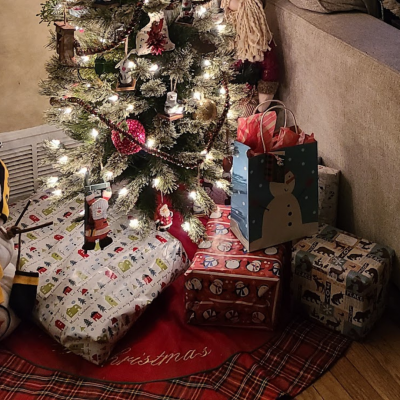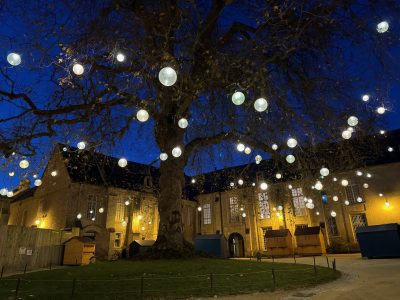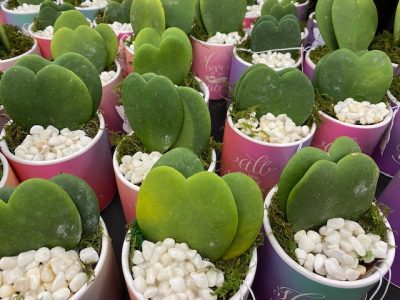By Heather Zidack, UConn Home Garden Education Office

If you have a gardener in your life, last minute holiday shopping can be tough. Each year, we provide a list of suggestions that might help you as you’re shopping. For 2025, we are considering gardener comfort and adaptability.
Gardening Gloves
While it seems like a trivial gift and your gardener may already have a good pair, gardening gloves are a great gift! It’s always nice to have an extra pair in case your hands get wet working in muddy soil, or if you manage to lose them. Our gloves wear over time, and can thin, stretch, and decline in quality as seasons change. While any pair may be helpful as a backup pair, you might get bonus points for finding your gardener’s favorite brand or style. These are readily available in hardware stores or year-round garden centers.
UV Protective Clothing
With the improvement of UV protective textiles, gardeners can find them in all sorts of forms. UV shirts, gloves/sleeves, and even hats are available to help your gardener stay protected from the sun. This is great for anyone who loves being outdoors, but especially those who may have extra sensitivities to sunlight. While not a direct substitute for sunscreen, they can help provide a little extra protection. I find that these often are best found online, though I have seen individual items at independent garden centers, sporting stores, and gift shops throughout the state.
Cooling Towels
Athletic cooling towels are meant to help keep you cool. Soak them in cool water, wring out the excess and wear as a scarf or drape over your shoulders. The evaporative cooling from the towel helps you stay cool even during the warmest summer days. While they’re usually found with the sports gear, your gardener will love them, too!
Waterproof Shoes
Nobody likes wet feet, especially in the garden. Help the gardener you love stay dry by gifting them with a pair of waterproof shoes! These come in many forms such as rubber rain boots, rubber clogs, or even waterproof sneakers. They can be found at sporting goods stores, shoe stores, or online.
Shop Smart
There are many gifts beyond these recommendations that may suit the gardener in your life. As we approach the last-minute shopping season, keep these tips in mind to help you find the perfect gift.
Look carefully at the label of any seed mixes, seed bombs, or other plantable gifts, especially if you are intending to gift native seeds. Many of these mixes sold across the country may provide plants native to North America, but not necessarily native to our region. The label provides a percentage breakdown of every species of seed included. Cross reference to ensure that they are native to our region.
Purchase durable tools and equipment over novelty items. Give your gardener gifts that they will be able to use for years to come. While gloves with claws to help you dig are fun and unique, a good trowel will stay part of your gardener’s arsenal for many years.
Consider your gardener’s interests to help guide your gifting. If your loved one plants more flowers than vegetables, a garden hod might not be the right fit for them. If they hate weeding, a gift to make the chore easier might be a great fit! Think about the ways the person you’re gifting likes to spend time in their garden and tailor your gift to them.
Don’t rule out experiential gifts just because it’s winter. Gardeners who wish to continue to learn and spend time with like-minded green thumbs may enjoy a workshop, class, or conference. Many regional garden shows (including the CT Flower & Garden Show) take place during the winter. Local garden clubs, libraries, or garden centers may also offer educational workshops that you could purchase tickets for in advance.
Shop smart. While we can’t recommend any brands or specific places to shop, use your smart consumer skills when looking for these or any other gifts this season. Reading reviews, using trusted retailers, and balancing quality with price will help you verify that these gifts will impress.
If you’re shopping last minute for that gardener in your life, remember that it doesn’t have to be stressful! Keep comfort, adaptability, and their unique interests in mind for a gift that’s sure to please!
The UConn Home & Garden Education Center supports UConn Extension’s mission by providing answers you can trust with research-based information and resources. For gardening questions, contact us toll-free at (877) 486-6271, visit our website at homegarden.cahnr.uconn.edu, or reach out to your local UConn Extension Center at extension.uconn.edu/locations.
This article was published in the Hartford Courant December 20, 2025







